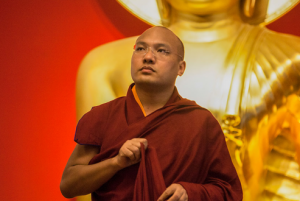Looking for the perfect Christmas gift? Why not buy them a contemporary, gripping retelling of the Buddha’s life? To date, the late Osamu Tezuka’s (Astro Boy) monumental graphic novel series Buddha remains an unmatched masterpiece in the history of comics. Come May 2011, Warner Bros. Japan is due to release the first part of an animated feature film for Buddha, which covers eight volumes of rich storytelling, complex characters, typically Japanese gags, a Buddha who weeps, and surprisingly explicit violence. Almost no stone is left uncovered in Osamu’s retelling of the beloved stories surrounding ??kyamuni – except for his relationship with ??riputra and Maugdalyayana, which to me seem rather hastily introduced, shallow, and brief. Aside from that, however, the character development is simply stunning and has not been surpassed by other attempts at recasting a religious narrative in the graphic novel format (Manga Bible is one example of a somewhat wasted opportunity).
Despite its art style, which is instantly recognizable as belonging to the author of Astro Boy, this comic is not for kids. Scenes of questionable family wholesomeness include those of Kosala’s elephant armies squashing the doomed Sakya clan members, with a generous sight of Queen Vaidehi’s desperate attempts to feed the imprisoned Bimbisara (she sneaks into the prison tower with honey smeared over her body, and I’ll leave the rest to your imagination), poisonings, shootings, stabbings, and all the violence that is part and parcel of war and politics. There is even one scene in which a mother and son are run through in a particularly heartbreaking manner. Osamu’s Astro Boy art style makes it all the more stark and raw, in my opinion.
Buddha also has several fourth wall breaking jokes and gags, in which the characters sometimes address the readers or the contemporary world. One example is Queen Vaidehi chastising the young Ajatasatru for reading a raunchy lad’s mag, and he should stick with Disney and Mickey Mouse. On one occasion, the Buddha’s disciples are worried that someone will try to assassinate him during a public sermon and try convincing him to feign illness, claiming that it is an excuse used by comic artists to miss drawing an issue. Another joke I found amusing was ??riputra’s attempt to convince Devadatta’s monks to return to the Buddha, only to have Steven Spielberg’s ET (who has apparently taken the Vinaya vows and donned robes) say, “Sorry to disappoint you, Sariputta, but we don’t even want to phone home.” For all his Jedi wisdom, Yoda seems to have been deceived by Devadatta as well, and various other ET references are scattered throughout the comic. The humour is often irreverent and will almost certainly offend those who expect a clean, orthodox story.
What is amazing about this graphic novel is its focus on other characters. Even lesser known ones are given considerable attention and development, and the title Buddha is somewhat misleading since it really has many protagonists, and most of them are fleshed out to the point that one does begin to care for them – even the “villains” like Ajatasatru.
Another issue Buddhists have reprimanded Osamu for is his depiction of Gautama as a rather imperfect man. Even after his enlightenment, he cries and suffers emotional torment on several occasions. He is tormented by the king of Kosala’s decision to annihilate the Sakyas and weeps heavily upon knowing the deaths of ??riputra and Maugdalyayana. He also visibly suffers from his illnesses and dysentery. I am reminded of Dr. Tadeusz Skorupski’s reference to the end of the Buddha’s earthly life: despite his intense meditation and ascension of the jhanas, historically speaking, “he must have died in agony.” Osamu holds nothing back in showing this side, this interpretation, of the Buddha’s journey and struggle, and in this sense departs greatly from traditional Mah?y?na accounts of his docetic illusion of a human life. Furthermore, Gautama is shown often talking to Brahman or God, who seems to be his guide when the tradition is very clear on the fact that the Buddha surpasses Brahman in wisdom. In this sense, Buddha suffers from some serious narrative flaws for a serious Buddhist who knows her doctrine.
Still, there’s no question about it: buy this manga series. There is currently no grander, more ambitious or epic attempt to capture the Buddha’s life in a multi-faceted manner. Even though Osamu Tezuka is no longer with us, his genius is still very much a part of modern pop culture. Buddha is not strictly “serious reading”, but within its pages are many touching things that elicit genuine emotion. After all, the very first scene is a famous one: a bear, fox, and rabbit hunt for food to feed an exhausted old man, and the rabbit, being unsuccessful, throws itself into a fire. Weeping, the grateful man offers the rabbit’s burnt corpse to the stars, and it is reborn as a great being.















